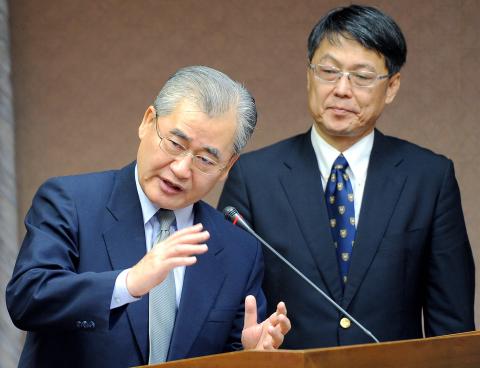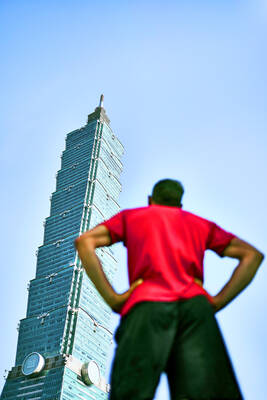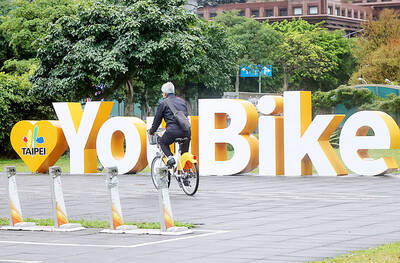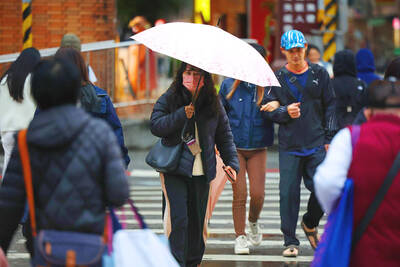Minister of Transportation and Communications Mao Chi-kuo (毛治國) yesterday said the ministry would spend three months evaluating various options for the rates of the new freeway toll fee, adding that the ministry would decide the date of implementation once the evaluation is complete.
The current system requires freeway drivers to pay a fee whenever they drive through toll booths, yet some freeway users may never have to drive through a toll booth and hence never pay any fees. To this end, the new “pay as you go” policy would require all freeway users to pay a toll based on the distance traveled.
The bureau has proposed three possible rate options: The first will not allow freeway users to drive a kilometer toll-free, with each car being charged NT$0.82 per kilometer traveled. The second would give each driver a toll-free distance of 10km per day, charging NT$1 for each kilometer thereafter. The third would increase the daily toll-free distance to 20km, but also push the rate up to NT$1.20 per kilometer if a person drives between 20km and 200km. The rate would drop to NT$0.90 after they pass the 200km mark.

Photo: Chu Pei-hsiung, Taipei Times
Mao said the current system asks one-third of medium and long-distance freeway drivers to subsidize two-thirds of those who do not have to pay fees, which he said was unfair.
He said the ministry has been formulating the “pay as you go” policy under different administrations, which shows that the policy has gained support from both of the major parties.
Mao said the new policy would not increase total revenue for the Freeway Construction Fund, which was NT$22 billion (US$750.8 million) last year. The point of the policy was that freeway users who did not have to pay toll fees in the past would have to pay them now, relieving medium and long-distance drivers of the burden of subsidizing short-distance drivers.
“The three different rates have been presented for everyone to consider and we are seeking to reach a consensus on the chosen option,” he said. “We will not immediately announce which one of options will be used.”
Based on the bureau’s analysis, drivers who have never had to pay toll fees in the past would pay between NT$10.20 and NT$18.60 on average per trip, allowing those who have been paying to potentially save between NT$20.10 and NT$47.90 per trip.
Though the ministry said the new policy was fairer, it drew criticism from legislators and regular users of freeways running from east to west, including freeways No. 2, 4, 6, 8 and 10. The main reason for the protests was that drivers on these freeways are currently not required to pay toll fees.
The Democratic Progressive Party (DPP) called for an indefinite postponement of the policy and the reclassification of the current national highways to protect the financially vulnerable.
“The DPP caucus does not oppose the tolling mechanism, but the policy would likely be a punishment for residents in the rural areas before a coordinated set of supporting measures is formulated,” DPP Legislator Pan Men-an (潘孟安) told a press conference.
The caucus insisted that the measures should be postponed until supplementary measures are in place and the economy picks up, he said.
It also called for re-classifying national highways by designating east-west Highways No. 2, 4, 6, 8 and 10 as expressways so that they would not be included in the tolling scheme.
Unlike Highways No. 1, 3, 5 and 7, which connect northern and southern Taiwan, the east-west national highways connect rural and urban areas, and the majority of road users are farmers and blue-collar workers, who have to transport agricultural produce or commute between their hometowns and cities, DPP Legislator Hsu Chih-chieh (許智傑) said.
DPP legislators Chiu Chih-wei (邱志偉), who represented Greater Kaohsiung, Liu Chao-hao (劉櫂豪) of Taitung County and Chen Ou-po (陳歐珀) of Yilan County, all said the policy would affect local people’s livelihood.
Furthermore, DPP Legislator Lee Kun-tse (李昆澤) accused the ministry of disregarding a resolution proposed by the Transportation Committee, which demanded the reclassification of the East-West highways.
DPP Legislator Wei Ming-ku (魏明谷) proposed that the plan be postponed until GDP growth surpasses 6 percent, the unemployment rate is lower than 3 percent and national income per capita exceeds than US$30,000 (NT$879,000).
Mao responded that the nation would be mired in a NT$100 billion debt if freeways were changed to express ways.

US climber Alex Honnold is to attempt to scale Taipei 101 without a rope and harness in a live Netflix special on Jan. 24, the streaming platform announced on Wednesday. Accounting for the time difference, the two-hour broadcast of Honnold’s climb, called Skyscraper Live, is to air on Jan. 23 in the US, Netflix said in a statement. Honnold, 40, was the first person ever to free solo climb the 900m El Capitan rock formation in Yosemite National Park — a feat that was recorded and later made into the 2018 documentary film Free Solo. Netflix previewed Skyscraper Live in October, after videos

Starting on Jan. 1, YouBike riders must have insurance to use the service, and a six-month trial of NT$5 coupons under certain conditions would be implemented to balance bike shortages, a joint statement from transportation departments across Taipei, New Taipei City and Taoyuan announced yesterday. The rental bike system operator said that coupons would be offered to riders to rent bikes from full stations, for riders who take out an electric-assisted bike from a full station, and for riders who return a bike to an empty station. All riders with YouBike accounts are automatically eligible for the program, and each membership account

NUMBERS IMBALANCE: More than 4 million Taiwanese have visited China this year, while only about half a million Chinese have visited here Beijing has yet to respond to Taiwan’s requests for negotiation over matters related to the recovery of cross-strait tourism, the Tourism Administration said yesterday. Taiwan’s tourism authority issued the statement after Chinese-language daily the China Times reported yesterday that the government’s policy of banning group tours to China does not stop Taiwanese from visiting the country. As of October, more than 4.2 million had traveled to China this year, exceeding last year. Beijing estimated the number of Taiwanese tourists in China could reach 4.5 million this year. By contrast, only 500,000 Chinese tourists are expected in Taiwan, the report said. The report

Temperatures are forecast to drop steadily as a continental cold air mass moves across Taiwan, with some areas also likely to see heavy rainfall, the Central Weather Administration (CWA) said. From today through early tomorrow, a cold air mass would keep temperatures low across central and northern Taiwan, and the eastern half of Taiwan proper, with isolated brief showers forecast along Keelung’s north coast, Taipei and New Taipei City’s mountainous areas and eastern Taiwan, it said. Lows of 11°C to 15°C are forecast in central and northern Taiwan, Yilan County, and the outlying Kinmen and Lienchiang (Matsu) counties, and 14°C to 17°C